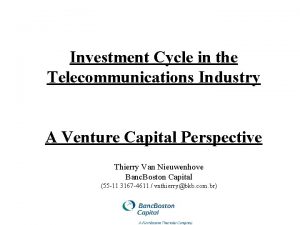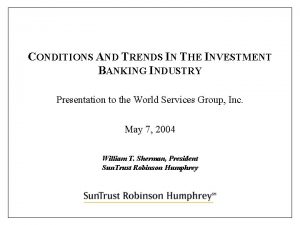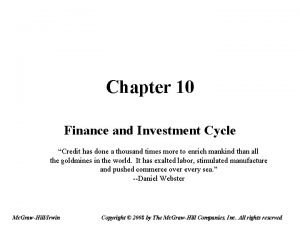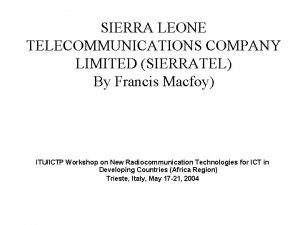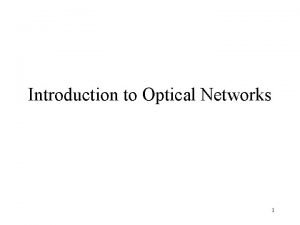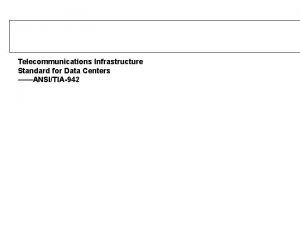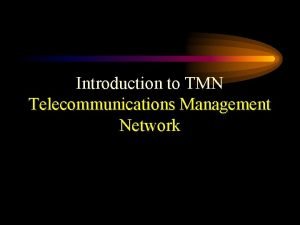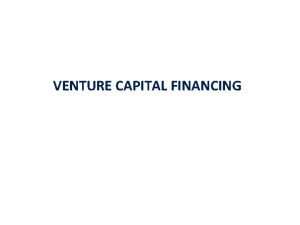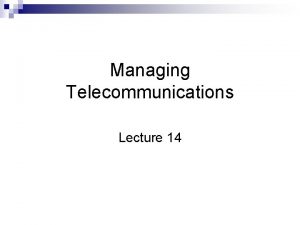Investment Cycle in the Telecommunications Industry A Venture


















- Slides: 18

Investment Cycle in the Telecommunications Industry A Venture Capital Perspective Thierry Van Nieuwenhove Banc. Boston Capital (55 -11 3167 -4611 / vnthierry@bkb. com. br)

CONTENT • Before 1996 : The Natural Monopoly era • 1996 - 2000 : The Golden era • Since 2000 : The Restructuring

BEFORE 1996 : OVERVIEW • The telecommunications industry was seen as a boring, natural monopoly, similar to water, electricity and gas companies (“POTS”); • Companies were generally state-owned (except US); • Cash-flows were stable and predictable, growing in line with the installed base of phone lines; • Although technological innovations were introduced (i. e analog to digital, wireless), these did not structurally transform the industry’s structure.

BEFORE 1996 : EARLY SIGNS OF CHANGES • Creation of MCI in 1970; • Privatization of British Telecom, creation of a duopoly structure and development of cable telephony industry in the U. K. in the 80’s; • Privatization of state-owned monopolies in Western Europe, Asia and Latam in the early 90’s; • Introduction of multi-carriers systems for long-distance calls in Chile in 1994; • Creation of a dynamic, competitive wireless industry (first VC funding).

Before 1996 : PRIVATIZATIONS Telecoms privatization 1984 - 96 Total : $ 159 Bn Source : ITU Number of privatizations 1990 - 96 Total : 61

Period 1996 - 2000 : Background • Combination of three factors led to an unprecedented investment boom in the telecom sector : • Liberalization / deregulation (Telecom Act of 96, EU’s directive for a single market for telecoms services by 98, introduction of WTO rules in 98) => $120 Bn US local telecom market open to new entrants; • Technological innovation (Internet/Data, LMDS, CDMA, DSL, . . . ) => Opportunity to offer new services at more attractive prices; • Strong economic growth in the US and Western Europe => Availability of capital +Optimism about telecom market growth.

PERIOD 1996 - 2000 : Investment Boom Source : JP Morgan; Pegasus

Period 1996 - 2000 : Types of investors • The opening of the market was seen as an opportunity by 3 different classes of equity investors : • Telecommunications companies (geographical expansion or product extension); • Large conglomerates diversifying into the telecommunications industry (Mannesman, Hutchison, Andrade Gutierrez, Impsa, . . . ); • VC’s backing “emerging telcos” using novel technologies to leap into new markets (Colt, Covad, Winstar, Diveo, Metrored, Vesper, Optiglobe, . . . ).

PERIOD 1996 - 2000 : Emerging telcos Source : Thomson Financial, DBAB

PERIOD 1996 - 2000 : Role of Venture Capital Source : Venture. One

Period 1996 - 2000 : VC interest in the sector • Large market opportunity : Size of the US telecom industry of $260 Bn; • Optimism related to growth of new services / technologies (“Internet traffic growing at 100% per quarter in 1 H 97”); • VC “overfunding”; • Possibility to invest large $ amounts per transaction. Source : Venture Economics

PERIOD 1996 - 2000 : Role of Venture Capital Source : Venture. One, Natl. Venture Capital Association

Turning Point : European 3 G Licences • 3 G auctions in Europe marked the peak of the telecom bubble and the reversal of investors’ perception; • More than US$100 Bn were committed without any clear understanding of financial returns, market potential, customer needs, services / products, technology availability, . . .

Since 2000 : Sector Underperformance Source : Bloomberg, Banc. Boston Capital

Since 2000 : Downward Spiral • Plunge in market values of listed telecommunications companies; • Liquidation or debt restructuring of most emerging telcos; • Credit rating downgrades of several incumbent companies reflecting a worsening of the fundamentals even among blue chip telecom companies. Source : Bloomberg, S&P

Since 2000 : Emerging Telcos’ Woes? • Overexpansion : Geographic, Product and Customer; • Overcapacity : Number of US CLEC’s jumped from 50 to 500 between 1995 and 2000; • Debt overload : • Dismal operating performance : Industry ROE plunged from 20% in 1996 to 5% in 2000, while most emerging telcos are still EBITDA negative; • Regulatory issues : Incumbent’s “obstructive” behavior; • Economic downturn : Impact on take-up of new services, pricing, churn, . . .

Current Trends : Emerging Telcos • Concentration / Consolidation • More bankruptcies (PSINet, Winstar, . . . ); • Sale of troubled companies’ assets (Exodus, Global Crossing, . . . ); • Limited Mergers and Acquisitions activity (Digex, Pegaso, . . . ). • Restructuring of balance sheet • Capital injection by existing or new shareholders (Vesper, Globo Cabo, . . . ); • Renegotiation of existing liabilities (Covad, Impsat, Vesper, Pagenet, . . . ). • Focus on operating performance / cash flows • Cost reductions; • Narrowing of companies’ focus; • Capex cutbacks and infrastructure sharing. • Best companies will survive and prosper in the medium term.

Thank You Very Much !
 Venture capital telecommunications
Venture capital telecommunications Wireless telecommunications industry analysis
Wireless telecommunications industry analysis Professional venture investing cycle
Professional venture investing cycle Fixed investment and inventory investment
Fixed investment and inventory investment Investment banking trends
Investment banking trends Financing and investing cycle
Financing and investing cycle Investment phase of project development cycle
Investment phase of project development cycle Investing cycle in auditing
Investing cycle in auditing A pioneer in the field of telecommunications
A pioneer in the field of telecommunications Project management telecommunications
Project management telecommunications Telecommunication meaning
Telecommunication meaning Osha telecommunications standards
Osha telecommunications standards Sierra leone telecommunications company
Sierra leone telecommunications company Telecommunications act of 1996
Telecommunications act of 1996 Telecommunications network architecture
Telecommunications network architecture Unstructured cabling
Unstructured cabling Tmn physical architecture
Tmn physical architecture Electronics and telecommunications research institute
Electronics and telecommunications research institute Telecommunications, the internet, and wireless technology
Telecommunications, the internet, and wireless technology
